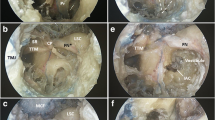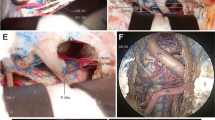Abstract
Background
The combined transpetrosal approach (CTPA) is a versatile technique suitable for challenging skull base pathologies. Despite the advantages provided by a wide surgical exposure, the soft tissue trauma, complex and time-consuming bony work, and cosmetic issues make it far from patient expectations. In this study, the authors describe a less invasive modification of the CTPA, the mini-combined transpetrosal approach (mini-CTPA), and perform a quantitative comparison between these two approaches.
Methods
Five human specimens were used for this study. CTPA was performed on one side and mini-CTPA on the opposite side. The surgical freedom, petroclival and brainstem area of exposure, and maneuverability for 6 anatomical targets, provided by the CTPA and mini-CTPA, were calculated and statistically compared. The bony volumes corresponding to each anterior petrosectomy were also measured and compared. Three clinical cases with an operative video are also reported to illustrate the effectiveness of the approach.
Results
The question-mark skin incision done along the muscle attachments permits an optimal cosmetic result. Even though the limited incision, the smaller craniotomy, and the less extensive bone drilling of mini-CTPA provide a smaller area of surgical freedom, the areas of exposure of petroclival region and brainstem were not statistically different between the two approaches. The antero-posterior maneuverability for the oculomotor foramen (OF), Meckel’s cave (MC) and the REZ of trigeminal nerve, and the supero-inferior maneuverability for OF, MC, Dorello’s canal, and REZ of CN VII are significantly reduced by the smaller opening. The bony volume of anterior petrosectomy resulted similar among the approaches.
Conclusions
The mini-CTPA is an interesting alternative to the CTPA, providing comparable surgical exposure both for petroclival region and for brainstem. Although the lesser soft tissue dissection and bony opening decrease the surgical maneuverability, the mini-CTPA may reduce surgical time, potential approach-related morbidities, and improve cosmetic and functional outcomes for the patients.








Similar content being viewed by others
Abbreviations
- TSSJ:
-
Transverse-sigmoid sinus junction
- SS:
-
Sigmoid sinus
- PFD:
-
Posterior fossa dura
- LSC:
-
Lateral semicircular canal
- SSC:
-
Superior semicircular canal
- PSC:
-
Posterior semicircular canal
- TS:
-
Transverse sinus
- FS:
-
Foramen spinosum
- ACP:
-
Anterior clinoid process
- PCP:
-
Posterior clinoid process
- FR:
-
Foramen rotundum
- FO:
-
Foramen ovale
- FS:
-
Foramen spinosum
- FL:
-
Foramen lacerum
- MC:
-
Meckel’s cave
- IAC:
-
Internal acoustic meatus
- PCJ:
-
Petroclival junction
- JF:
-
Jugular foramen
- OF:
-
Oculomotor foramen
- DC:
-
Dorello’s canal
- AICA:
-
Anterior inferior cerebellar artery
- REZ V and VII:
-
Root entry zone of trigeminal and facial nerves
References
Abdel Aziz KM, Sanan A, van Loveren HR, Tew JMJ, Keller JT, Pensak ML (2000) Petroclival meningiomas: predictive parameters for transpetrosal approaches. Neurosurgery 47(1):132–139
Al-Mefty O, Ayoubi S, Kadri PAS (2008) The petrosal approach for the resection of retrochiasmatic craniopharyngiomas. Neurosurgery 62(5 Suppl 2):ONS331–ONS335 discussion ONS335-6
Al-Mefty O, Fox JL, Smith RR (1988) Petrosal approach for petroclival meningiomas. Neurosurgery 22(3):510–517
Aum D, Rassi MS, Al-mefty O (2020) Petroclival meningiomas and the petrosal approach, 1st ed. Meningiomas. https://doi.org/10.1016/B978-0-12-822198-3.00035-5
Bambakidis NC, Kakarla UK, Kim LJ, Nakaji P, Porter RW, Daspit CP, Spetzler RF (2008) Evolution of surgical approaches in the treatment of petroclival meningiomas: a retrospective review. Neurosurgery. https://doi.org/10.1227/01.NEU.0000280119.36270.BA
Cho CW, Al-Mefty O (2002) Combined petrosal approach to petroclival meningiomas. Neurosurgery 51(3):708
Couldwell WT, Fukushima T, Giannotta SL, Weiss MH (1996) Petroclival meningiomas: surgical experience in 109 cases. J Neurosurg 84(1):20–28
Day JD, Fukushima T, Giannotta SL Cranial base approaches to posterior circulation aneurysms. J Neurosurg 87(4):544–554
de Andrade Júnior FC, de Andrade FC, de Araujo Filho CM, Carcagnolo Filho J (1998) Dysfunction of the temporalis muscle after pterional craniotomy for intracranial aneurysms. Comparative, prospective and randomized study of one flap versus two flaps dieresis. Arq Neuropsiquiatr 56(2):200–205
Di Carlo DT, Capo G, Fava A, Cagnazzo F, Margil-Sànchez M, Champagne PO, Voormolen EHJ, Morganti R, Froelich S, Perrini P (2020) Petroclival meningiomas: the risk of post-operative cranial nerve deficits among different surgical approaches—a systematic review and meta-analysis. Acta Neurochir 162(9):2135–2143
Erkmen K, Pravdenkova S, Al-Mefty O (2005) Surgical management of petroclival meningiomas: factors determining the choice of approach. Neurosurg Focus. https://doi.org/10.3171/foc.2005.19.2.8
Figueiredo EG, Paulo S, Nakaji P, Crawford NDP (2007) Surgical anatomy and technique description and anatomic assessment. Neurosurgery 61(November):256–265
Goudihalli SR, Morisako H, Prastarana W, Goto T, Ohata H, Ohata K (2018) Contralateral minimum anterior and posterior combined petrosal approach for retrochiasmatic craniopharyngiomas: an alternative technique. J Neurol Surg Part B Skull Base 79(2):S208–S210
Hakuba A, Nishimura S, Inoue Y (1985) Transpetrosal-transtentorial approach and its application in the therapy of retrochiasmatic craniopharyngiomas. Surg Neurol 24(4):405–415
Hakuba A, Nishimura S, Jang BJ (1988) A combined retroauricular and preauricular transpetrosal-transtentorial approach to clivus meningiomas. Surg Neurol 30(2):108–116
Hanakita S, Watanabe K, Champagne P, Froelich S (2019) How I do it: combined petrosectomy.
Ichimura S, Takahara K, Mochizuki Y, Fujii K (2019) Intradural combined transpetrosal approach for primary pontine hemorrhage. World Neurosurg 127:194–198
Janjua MB, Caruso JP, Greenfield JP, Souweidane MM, Schwartz TH (2017) The combined transpetrosal approach: anatomic study and literature review. J Clin Neurosci Off J Neurosurg Soc Australas 41:36–40
Kadri PAS, Al-Mefty O (2004) The anatomical basis for surgical preservation of temporal muscle. J Neurosurg 100(3):517–522
Kunihiro N, Goto T, Ishibashi K, Ohata K (2014) Surgical outcomes of the minimum anterior and posterior combined transpetrosal approach for resection of retrochiasmatic craniopharyngiomas with complicated conditions. J Neurosurg 120(1):1–11
Kusumi M, Fukushima T, Mehta AI, Aliabadi H, Nonaka Y, Friedman AH, Fujii K (2012) Tentorial detachment technique in the combined petrosal approach for petroclival meningiomas: clinical article. J Neurosurg 116(3):566–573
Labidi M, Watanabe K, Loit M-P, Hanakita S, Froelich S (2018) The posterior transpetrosal approach in a case of large retrochiasmatic craniopharyngioma: operative video and technical nuances. J Neurol Surg B Skull Base 79(2):S205–S207
Matano F, di Russo P, Okano A, Passeri T, Penet N, Fava A, Camara B, Polivka M, Giammattei L, Froelich S (2020) Oculomotor neurofibroma: a different histology implying an unsatisfying clinical outcome. World Neurosurg 139:31–38
Mathiesen T, Gerlich Å, Kihlström L, Svensson M, Bagger-Sjöbäck D (2007) Effects of using combined transpetrosal surgical approaches to treat petroclival meningiomas. Neurosurgery 60(6):982–991
Morisako H, Goto T, Goto H, Bohoun CA, Tamrakar S, Ohata K (2016) Aggressive surgery based on an anatomical subclassification of craniopharyngiomas. Neurosurg Focus 41(6):1–15
Morisako H, Ohata H, Shinde B, Nagahama A, Watanabe Y, Goto T (2021) Minimal anterior and posterior combined transpetrosal approach for large petroclival meningiomas. J Neurosurg 135(4):1180–1189
Morisako H, Goto T, Ohata H, Goudihalli SR, Shirosaka K, Ohata K (2018) Safe maximal resection of primary cavernous sinus meningiomas via a minimal anterior and posterior combined transpetrosal approach. Neurosurg Focus 44(4):1–8
Morisako H, Goto T, Ohata K (2015) Petroclival meningiomas resected via a combined transpetrosal approach: surgical outcomes in 60 cases and a new scoring system for clinical evaluation. J Neurosurg 122(February):373–380
Ohue S, Fukushima T, Kumon Y, Ohnishi T, Friedman AH (2010) Surgical management of brainstem cavernomas: selection of approaches and microsurgical techniques. Neurosurg Rev 33(3):314–315
Quiñones-Hinojosa A, Chang EF, Lawton MT (2006) The extended retrosigmoid approach: an alternative to radical cranial base approaches for posterior fossa lesions. Neurosurgery 58(SUPPL. 2):208–214
Rabelo NN, da Costa BBS, Teixeira MJ, Figueiredo EG (2018) Letter to the Editor. Minimally invasive techniques: the new frontier in neurosurgery. J Neurosurg 130(1):330–331
Samii M, Alimohamadi M, Gerganov V (2014) Endoscope-assisted retrosigmoid intradural suprameatal approach for surgical treatment of trigeminal schwannomas. Oper Neurosurg 10(4):565–575
Samii M, Metwali H, Samii A, Gerganov V (2013) Retrosigmoid intradural inframeatal approach: indications and technique. Neurosurgery 73(1 Suppl Operative):53–60
Sekhar LN, Schessel DA, Bucur SD, Raso JL, Wright DC (1999) Partial labyrinthectomy petrous apicectomy approach to neoplastic and vascular lesions of the petroclival area. Neurosurgery 44(3):532–537
Siwanuwatn R, Deshmukh P, Figueiredo EG, Crawford NR, Spetzler RF, Preul MC (2006) Quantitative analysis of the working area and angle of attack for the retrosigmoid, combined petrosal, and transcochlear approaches to the petroclival region. J Neurosurg 104(1):137–142
Tatagiba M, Rigante L, Mesquita Filho P, Ebner FH, Roser F (2015) Endoscopic-assisted posterior intradural petrous apicectomy in petroclival meningiomas: a clinical series and assessment of perioperative morbidity. World Neurosurg 84(6):1708–1718
Teo C (2010) The concept of minimally invasive neurosurgery. Neurosurg Clin N Am 21(4):583–584
Vaca EE, Purnell CA, Gosain AK, Alghoul MS (2017) Postoperative temporal hollowing: is there a surgical approach that prevents this complication? A systematic review and anatomic illustration. J Plast Reconstr Aesthet Surg 70(3):401–415
Watanabe T, Katayama Y, Fukushima T, Kawamata T (2011) Lateral supracerebellar transtentorial approach for petroclival meningiomas: operative technique and outcome: clinical article. J Neurosurg 115(1):49–54
Wang EW, Zanation AM, Gardner PA et al (2019) ICAR: endoscopic skull-base surgery. Int Forum Allergy Rhinol 9(S3):S145–S365
Acknowledgements
We thank all the women and men who have donated their bodies for the advancement of scientific and surgical knowledge.
Author information
Authors and Affiliations
Contributions
Study conception and design: Arianna Fava and Sébastien Froelich. Material preparation, data collection, and analysis were performed by Arianna Fava, Paolo di Russo, Thibault Passeri, Breno Camara, Lorenzo Giammattei, and Sébastien Froelich. The first draft of the manuscript was written by Arianna Fava, and all authors commented on previous versions of the manuscript. All authors read and approved the final manuscript.
Corresponding author
Ethics declarations
Ethics approval
All procedures performed in studies involving human participants were in accordance with the ethical standards of the institutional and/or national research committee (Hôpital Lariboisière, Assistance Publique—Hôpitaux de Paris, Université Paris—Diderot) and with the 1964 Helsinki declaration and its later amendments or comparable ethical standards.
Conflict of interest
The authors declare no competing interests.
Additional information
Publisher’s note
Springer Nature remains neutral with regard to jurisdictional claims in published maps and institutional affiliations.
This article is part of the Topical Collection on Brain Tumors
Supplementary information
Video The mini-CTPA used for the treatment of different pathologies: part 1 shows a clival chordoma (case 1), part 2 a cerebellopontine angle epidermoid cyst (case 2), and part 3 a petroclival meningioma (case 3) (AVI 125292 kb)
Rights and permissions
About this article
Cite this article
Fava, A., di Russo, P., Passeri, T. et al. The mini-combined transpetrosal approach: an anatomical study and comparison with the combined transpetrosal approach. Acta Neurochir 164, 1079–1093 (2022). https://doi.org/10.1007/s00701-022-05124-x
Received:
Accepted:
Published:
Issue Date:
DOI: https://doi.org/10.1007/s00701-022-05124-x




